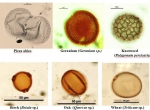Palynology
Palynology is a branch of botany, paleobotany and geology. Its name comes from the Greek word παλύνω – to strew, sprinkle. The term “palynology” was used for the first time in 1944 by British researchers H.A. Hyde and D.A. Williams. The focus of palynology are pollen grains and plant spores (fig. 1.) which are studied outside their parent plant. In recent years a growing number of other microfossils have come to be studied as well (e.g. →Non-pollen palynomorphs – NPPs). Fundamental to p. is the fact that pollen grain and plant spore morphology is species-specific which means that their diverse shapes and variously sculpted surface patterns make their taxonomic identification possible; moreover, thanks to the presence in their outer wall of chemically very stable compounds (e.g., sporopollenin) pollen grains and plant spores may survive in geological deposits for hundreds, thousands, even millions of years.
P. is an interdisciplinary science and cooperates with several research disciplines. In botany it assists the reconstruction of the history of plant communities and furnishes arguments to plant taxonomy studies and evidence for tracing evolutionary processes. In geology p. it is used to assess the age of strata from the Precambrian through to the Quaternary. In medicine it assists the diagnosis and treatment of diseases caused by allergy to pollen and fungal spores. P. has applications in agricultural sciences, forensics and even in the petroleum industry.
One of the major achievements of p. has been the development of pollen analysis. This method developed into an independent branch of learning, its overarching objective the reconstruction of the history of vegetation. The findings from p. are used also to reconstruct past climatic change. More recently, thanks to modern pollen record databases and the introduction of mathematical models, pollen analysis has gained new tools and can be used to make increasingly accurate spatial reconstructions.
Pollen analysis is frequently used in settlement studies in archaeology and history, helping to assess the condition of the environment of an area when it was under settlement and, subsequently, the impact of human activity on that settled area, as well as furnishing evidence on the nature of economy pursued there. In some situations pollen analysis is also useful for dating culture deposits or settlement contexts. P. studies carried out directly at an archaeological site have a special character and focus on anthropogenic material or on material which took form as a direct result of human occupation. In this case pollen analysis is made of samples taken from the culture deposit, water wells, cesspits, burial contexts. P. study can be made also of coprolites, especially of herbivorous animals, as well as food residues preserved in vessels recovered from archaeological sites.
ML, JŚM, AP, MZ
Literature: B. E. Berglund, M. Ralska-Jasiewiczowa, Pollen analysis and pollen diagrams, [in:] B. E. Berglund (ed.), Handbook of Holocene Palaeoecology and Palaeohydrology, 1986, p. 455-484; K. Faergi, J. Iversen, Textbook of Pollen Analysis, Chichester, New York, Brisbane, Toronto, Singapore 1989; P.D. Moore, J. A. Weeb, M.E. Collinson, Pollen analysis, Oxford 1991; Dybowa-Jachowicz, A. Sadowska (eds.), Palinologia, Kraków 2003; M. Latałowa, Badania palinologiczne na stanowiskach archeologicznych, [in:] S. Dybowa-Jachowicz, A. Sadowska (eds.), Palinologia, Kraków 2003, p. 308-312; H.-J. Beug, Leitfaden der Pollenbestimmung für Mitteleuropa und angrenzende Gebiete, München 2004; Latałowa M. Gospodarka człowieka w diagramach pyłkowych, [in:] M. Makohonienko, D. Makowiecki, Z. Kurnatowska (eds.), Studia interdyscyplinarne nad środowiskiem i kulturą w Polsce, Środowisko-Człowiek-Cywilizacja, t. I, Poznań 2007, p. 171-187.
-
 full resolution
full resolution
Fig. 1. Pollen grains seen under an optical microscope magnified 400x. Photo A. Pędziszewska and M. Zimny.


